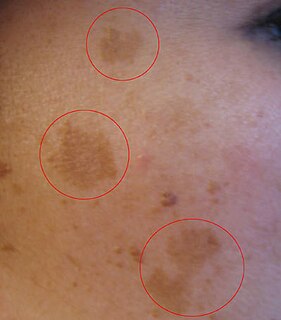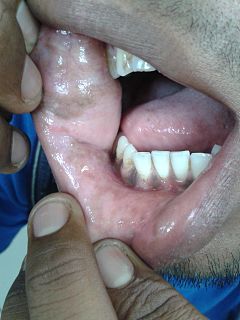This article needs additional citations for verification .(September 2018) |
Drug induced pigmentation may take on many different appearances, one of the most common being a change in the color, or pigmentation, of the skin.
This article needs additional citations for verification .(September 2018) |
Drug induced pigmentation may take on many different appearances, one of the most common being a change in the color, or pigmentation, of the skin.
| Drug/Drug Group | Clinical Features [1] |
|---|---|
| NSAIDs | Purple, red, yellow, slate, or blue-grey pigmented macules on the extremities and trunk – drug eruption |
| Antimalarials | Blue-ish pigmentation of lower extremities, but can also involve the entire nail bed, nose, cheeks, forehead, ears, and oral mucosa |
| Psychotropic Drugs | Blue-gray pigmentation on sun-exposed areas |
| Amiodarone | Blue-gray pigmentation on sun-exposed areas and yellow stippling of cornea |
| Tetracyclines | Brown pigmentation, most often on teeth |
| Heavy Metals | Gold – blue-gray pigmentation on sun-exposed areas, Silver – Silver granules in skin, nails, mucous membranes |
| Cytotoxic drug | Variable by molecule |
Drug-induced pigmentation of the skin may occur as a consequence of drug administration, and the mechanism may be postinflammatory hyperpigmentation in some cases, but frequently is related to actual deposition of the offending drug in the skin. [2] : 125–6 The incidence of this change varies, and depends on the type of medication involved. Some of the most common drugs involved are NSAIDs, antimalarials, psychotropic drugs, Amiodarone, cytotoxic drugs, tetracyclines, and heavy metals such as silver and gold (which must be ingested, not just worn). [1]
There are 4 possible mechanisms to how this change may occur: [1]

Human skin color ranges from the darkest brown to the lightest hues. Differences in skin color among individuals is caused by variation in pigmentation, which is the result of genetics, exposure to the sun, natural and sexual selection, or all of these. Differences across populations evolved through natural or sexual selection, because of social norms and differences in environment, as well as regulations of the biochemical effects of ultraviolet radiation penetrating the skin.

Vitiligo is a disorder that causes the skin to lose its color. Specific causes are unknown but studies suggest a link to immune system changes.

Alkaptonuria is a rare inherited genetic disease which is caused by a mutation in the HGD gene for the enzyme homogentisate 1,2-dioxygenase ; if a person inherits an abnormal copy from both parents, the body accumulates an intermediate substance called homogentisic acid in the blood and tissues. Homogentisic acid and its oxidized form alkapton are excreted in the urine, giving it an unusually dark color. The accumulating homogentisic acid causes damage to cartilage and heart valves, as well as precipitating as kidney stones and stones in other organs. Symptoms usually develop in people over 30 years old, although the dark discoloration of the urine is present from birth.

Hair color is the pigmentation of hair follicles due to two types of melanin: eumelanin and pheomelanin. Generally, if more melanin is present, the color of the hair is darker; if less melanin is present, the hair is lighter. The tone of the hair is dependent on the ratio of black or brown eumelanin to yellow or red pheomelanin. Levels of melanin can vary over time causing a person's hair color to change, and it is possible to have hair follicles of more than one color on the same person. Some hair colors are associated with some ethnic groups due to observed higher frequency of particular hair color within their geographical region, e.g. straight dark hair amongst East Asians, a large variety of dark, fair, curly, wavy and bushy hair amongst Europeans, curly, dark, and uniquely helical hair with Africans, whilst gray, white or "silver" hair is often associated with age and wisdom.

Nevus is a nonspecific medical term for a visible, circumscribed, chronic lesion of the skin or mucosa. The term originates from nævus, which is Latin for "birthmark"; however, a nevus can be either congenital or acquired. Common terms, including mole, birthmark, and beauty mark, are used to describe nevi, but these terms do not distinguish specific types of nevi from one another.

Hyperpigmentation is the darkening of an area of skin or nails caused by increased melanin.

Melasma is a tan or dark skin discoloration. Melasma is thought to be caused by sun exposure, genetic predisposition, hormone changes, and skin irritation. Although it can affect anyone, it is particularly common in women, especially pregnant women and those who are taking oral or patch contraceptives or hormone replacement therapy medications.
Chrysiasis is a dermatological condition induced by the parenteral administration of gold salts, usually for the treatment of rheumatoid arthritis. Such treatment has been superseded as the best practice for treating the disease because of "numerous side effects and monitoring requirements, their limited efficacy, and very slow onset of action".

Permanent makeup is a cosmetic technique which employs tattoos as a means of producing designs that resemble makeup, such as eye-lining and other permanent enhancing colors to the skin of the face, lips, and eyelids. It is also used to produce artificial eyebrows, particularly in people who have lost them as a consequence of old age, disease, such as alopecia totalis, chemotherapy, or a genetic disturbance, and to disguise scars and hypopigmentation in the skin such as in vitiligo. It is also used to restore or enhance the breast's areola, such as after breast surgery.
Carotenosis is a benign and reversible medical condition where an excess of dietary carotenoids results in orange discoloration of the outermost skin layer. The discoloration is most easily observed in light-skinned people and may be mistaken for jaundice. Carotenoids are lipid-soluble compounds that include alpha- and beta-carotene, beta-cryptoxanthin, lycopene, lutein, and zeaxanthin. The primary serum carotenoids are beta-carotene, lycopene, and lutein. Serum levels of carotenoids vary between region, ethnicity, and sex in the healthy population. All are absorbed by passive diffusion from the gastrointestinal tract and are then partially metabolized in the intestinal mucosa and liver to vitamin A. From there they are transported in the plasma into the peripheral tissues. Carotenoids are eliminated via sweat, sebum, urine, and gastrointestinal secretions. Carotenoids contribute to normal-appearing human skin color, and are a significant component of physiologic ultraviolet photoprotection.

Biological pigments, also known simply as pigments or biochromes, are substances produced by living organisms that have a color resulting from selective color absorption. Biological pigments include plant pigments and flower pigments. Many biological structures, such as skin, eyes, feathers, fur and hair contain pigments such as melanin in specialized cells called chromatophores. In some species, pigments accrue over very long periods during an individual's lifespan.

The human skin is the outer covering of the body and is the largest organ of the integumentary system. The skin has up to seven layers of ectodermal tissue guarding muscles, bones, ligaments and internal organs. Human skin is similar to most of the other mammals' skin, and it is very similar to pig skin. Though nearly all human skin is covered with hair follicles, it can appear hairless. There are two general types of skin, hairy and glabrous skin (hairless). The adjective cutaneous literally means "of the skin".

Smoker's melanosis is seen with the naked eye as a brown to black pigmentation of the oral tissue i.e. the gums, cheeks or palate as well as in larynx. It is most often seen in the lower labial gingiva of tobacco users. Most easily it is found in Caucasians, due to their lack of a genetically caused melanin pigmentation.

Discoid lupus erythematosus is the most common type of chronic cutaneous lupus (CCLE), an autoimmune skin condition on the lupus erythematosus spectrum of illnesses. It presents with red, painful, inflamed and coin-shaped patches of skin with a scaly and crusty appearance, most often on the scalp, cheeks, and ears. Hair loss may occur if the lesions are on the scalp. The lesions can then develop severe scarring, and the centre areas may appear lighter in color with a rim darker than the normal skin. These lesions can last for years without treatment.

Light skin is a human skin color that has a base level of eumelanin pigmentation that has adapted to environments of low UV radiation. Light skin is most commonly found amongst the native populations of Europe and East Asia as measured through skin reflectance. People with light skin pigmentation are often referred to as "white" or "fair", although these usages can be ambiguous in some countries where they are used to refer specifically to certain ethnic groups or populations.
Photoaging or photoageing is a term used for the characteristic changes to skin induced by chronic UVA and UVB exposure. Tretinoin is the best studied retinoid in the treatment of photoaging.
Oral pigmentation is asymptomatic and does not usually cause any alteration to the texture or thickness of the affected area. The colour can be uniform or speckled and can appear solitary or as multiple lesions. Depending on the site, depth, and quantity of pigment, the appearance can vary considerably.

Actinic elastosis, also known as solar elastosis, is an accumulation of abnormal elastin in the dermis of the skin, or in the conjunctiva of the eye, which occurs as a result of the cumulative effects of prolonged and excessive sun exposure, a process known as photoaging.
Skin cancer, or neoplasia, is the most common type of cancer diagnosed in horses, accounting for 45 to 80% of all cancers diagnosed. Sarcoids are the most common type of skin neoplasm and are the most common type of cancer overall in horses. Squamous-cell carcinoma is the second-most prevalent skin cancer, followed by melanoma. Squamous-cell carcinoma and melanoma usually occur in horses greater than 9-years-old, while sarcoids commonly affect horses 3 to 6 years old. Surgical biopsy is the method of choice for diagnosis of most equine skin cancers, but is contraindicated for cases of sarcoids. Prognosis and treatment effectiveness varies based on type of cancer, degree of local tissue destruction, evidence of spread to other organs (metastasis) and location of the tumor. Not all cancers metastasize and some can be cured or mitigated by surgical removal of the cancerous tissue or through use of chemotherapeutic drugs.

Dark skin is a type of human skin color that is rich in melanin pigments. People with very dark skin are often referred to as "black people", although this usage can be ambiguous in some countries where it is also used to specifically refer to different ethnic groups or populations.